Achieving a Decarbonized Society
- Efforts to Achieve a Decarbonized Society
- Environmental Strategy for Achieving a Decarbonized Society
- Expanding the Decarbonization Business
- Decarbonization Business Case Examples
- Avoided Emissions
- Improving the Environmental Performance of Products and Services Through Eco-Design
- Reduction of Product and Service CO2 Emissions During Use
- CO2 Emission Reductions at Business Sites (Factories and Offices) and Hitachi Carbon Neutrality 2030
- The Hitachi Internal Carbon Pricing Framework
- Activities and Achievements at Business Sites (Factories and Offices)
- Introducing Renewable Energy
- Initiatives to Reduce CO2 Emissions from Purchased Goods and Services
- Reducing Transportation Energy Consumption
- Hitachi Fleet Management Reduces CO2 Emissions from Business Vehicles
Efforts to Achieve a Decarbonized Society
Approach & Policy
Materiality
Tackling climate change has become a global issue, and the roles required of governments and companies have changed dramatically. With our participation in the 28th Conference of the Parties (COP28) to the United Nations Framework Convention on Climate Change, Hitachi aims to become a Climate Change Innovator, tackling environmental issues from a global perspective while deepening cooperation with governments and stakeholders to accelerate the transition to a decarbonized society .
Hitachi, under its "GX for CORE", which is one of the two pillars of our green strategy, will accelerate measures to reduce its own CO2 emissions to achieve carbon neutrality at business sites (factories and offices) by the fiscal 2030.
Additionally, as stated in our long-term environmental targets, Hitachi Environmental Innovation 2050, we are working towards achieving carbon neutrality across the entire value chain by fiscal 2050. Under GX for CORE, one of the two pillars of our green strategy, we are accelerating measures to reduce our own CO2 emissions to achieve carbon neutrality by fiscal 2030 at our business sites (factories and offices). And under GX for GROWTH, we aim to contribute to realize a decarbonized society by collaborating with stakeholders through the growth of green businesses. For example, Hitachi Energy will invest approximately $6 billion (as of June 2024) between fiscal years 2024 and 2027 to enhance manufacturing capacity and strengthen research and development, helping to accelerate the clean energy transition. This will also help to reduce emissions during the use of our products and services, which account for the majority of CO2 emissions in Hitachi's value chain. Hitachi will tackle environmental issues head-on by providing products and services with minimal environmental impact and by offering a wider range of solutions that reduce CO2 emissions for customers and society.
Ratio of CO2 Emissions at Each Stage of Hitachi's Value Chain in Fiscal 2023*1

*1Percentages may fluctuate due to changes in our business portfolios
Environmental Strategy for Achieving a Decarbonized Society
Strategy & Target
Initiatives for Achieving a Decarbonized Society
- Achieve carbon neutrality at our own business sites and production activities (by fiscal 2030)
- Introduce energy-saving and renewable energy equipment.
- Procure 100% non-fossil electricity across all business sites.
- Achieve the world’s highest level of energy conservation in products
- Achieve energy conservation by developing products that take the environment into consideration from the design stage.
- Work with procurement partners toward a decarbonized society
- Distributed Sustainable Procurement Guidelines and Green Procurement Guidelines, requesting all procurement partners to set CO2 emission reduction targets
- Selected 21 environmentally advanced partners in fiscal 2022 and collaborated on emissions reduction methods, calculation methods, data collection and analysis methods, and how best to utilize them. Expanded our reduction activities to approximately 100 companies in fiscal 2023, by using these knowledge and methods.
- Support businesses that contribute to the carbon neutrality of society as a whole
- Power grids business to support the expansion of renewable energy.
- Provision of energy-efficient high-speed trains and storage battery hybrid trains for the spread of carbon-free mobility.
- Provide Lumada solutions that support the realization of a decarbonized society through digitalization.
- Develop technologies to realize the transition to a decarbonized society
- Development of high-efficiency products, energy management systems and hydrogen-related technologies.
Green Strategy
- GX for CORE: Achieve carbon neutrality at business sites (factories and offices) by FY2030. Reduce CO2 emissions by 50% compared with fiscal 2010 levels by fiscal 2030 and achieve carbon neutrality across the entire value chain by fiscal 2050
- GX for GROWTH: Contribute to the decarbonization of customers and society through products and services having with low environmental impact (avoided emissions: 100 million metric tons in fiscal 2024)
Expanding the Decarbonization Business
Approach & Policy
Activities
Hitachi provides value to customers and society, contributing to a decarbonized society through businesses that reduce CO2 emissions and collaborative creation with customers. Hitachi operates three business sectors: Green Energy and Mobility, Digital Systems and Services, and Connective Industries. Among these sectors, we are growing the following businesses, which contribute to decarbonization.
- Businesses that help to accelerate the energy shift aimed at realizing decarbonization, and that provide safe, comfortable, and clean mobility (Green Energy and Mobility)
- Businesses that help to reduce CO2 emissions by using cutting-edge digital technologies to improve the efficiency of systems that underpin society (Digital Systems and Services)
- Businesses that contribute to the decarbonization of industry and society by providing products and services that have a low environmental impact when used by customers (Connective Industries)
Examples of Decarbonization Business: A Hitachi Focus
|
Green Energy & Mobility |
Power grid solutions |
|
|---|---|---|
| Grid automation |
|
|
| Power generation |
|
|
| Railway business |
|
|
|
Digital Systems & Services |
Finance and public oriented solutions |
|
| Data centers |
|
|
| Servers / storage |
|
|
|
Connective Industries |
Smart logistics |
|
| Factory automation |
|
|
| Water business |
|
|
| Industrial products |
|
|
| Smart cities |
|
|
| Home appliances |
|
|
| Next generation batteries |
|
|
| Elevators |
|
*1HVDC: High Voltage Direct Current
Decarbonization Business Case Examples
Activities
Hitachi contributes to reducing customers' CO2 emissions mainly in the following three areas.
(1) Transition to Non-fossil Energy
Contribute by providing key components for the introduction of non-fossil energy, including renewable energy.
High Voltage Direct Current (HVDC)
Hitachi Energy's High Voltage Direct Current (HVDC) efficiently transmits large amounts of energy over long distances from remote locations to demand areas, supporting output fluctuations and stabilizing interconnected AC systems. As a transmission technology, indispensable for the mass introduction of renewable energy, it is contributing to the transformation and flexibility of the energy system.
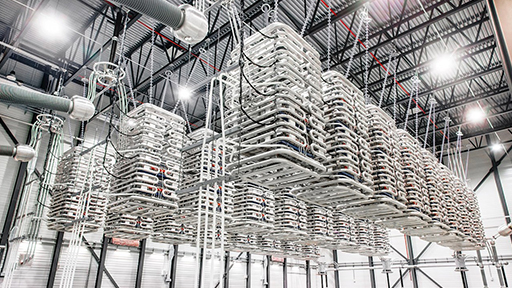
(2) Energy Saving
Contributing by providing energy efficiency through high-efficiency products and optimization of control, such as high-efficiency industrial equipment, to achieve energy savings
Air compressor
Hitachi Industrial Equipment Systems' air compressors reduce CO2 emissions by improving energy efficiency through enhanced performance of the compressor unit and increased efficiency of the motor. Hitachi contributes to decarbonization of the industrial sector through its energy-efficient equipment.
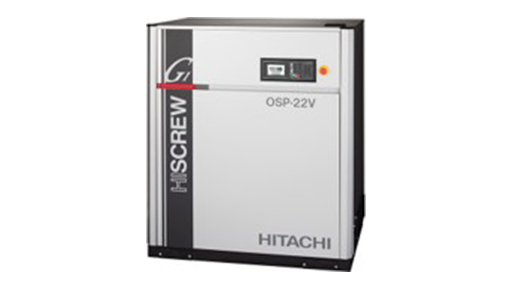
(3) Electrification
Contributing by electrifying products that utilize fossil energy, including industrial machinery.
Electrification systems for mining dump trucks
Hitachi Industrial Products provides electrification systems for mining dump trucks, where an engine drives a generator that produces electricity for driving and control, thereby improving the driving and control performance of the vehicles and helping to reduce CO2 emissions.
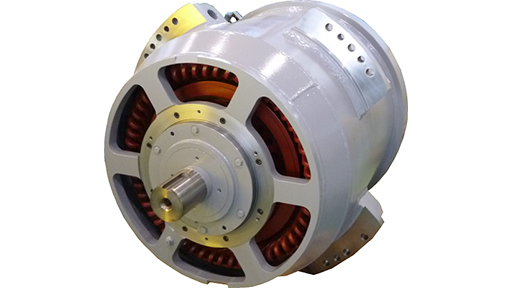
Achievements in Fiscal 2023
In fiscal 2023, Hitachi provided technologies and solutions that contribute to decarbonization in various fields, including the following examples
Contributing to maximum renewable energy utilization through digital control
With the anticipated increase in electricity demand due to the expanding use of generative AI, leveraging renewable energy for carbon neutrality is urgently needed. Hitachi supports the use of renewable energy with digital technology that integrates information technology (IT) with operational technology (OT). This includes providing cross-regional grid management systems that deliver renewable energy from production sites to distant consumption areas, as well as next-generation nationwide load dispatching system and electricity balancing market systems that support grid stabilization, which becomes more critical as renewable energy usage grows. The next-generation nationwide load dispatching system ordered in November 2023 will be built by combining Hitachi's expertise in power systems accumulated over many years with Hitachi Energy's global products.
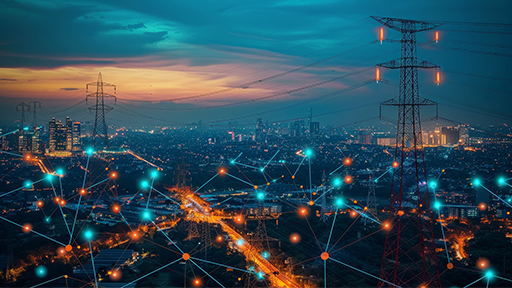
Contributing to urban transport electrification and modal shift (transforming transportation methods)
Hitachi Rail has announced the completion of the first phase of the Skyline, the first fully automated urban rail system in the USA, and the start of passenger service in Honolulu, Hawaii, USA in June 2023. It is estimated that once the entire new line is completed, an estimated 40,000 private car movements per day on the city's congested streets and highways (equivalent to eight highway lanes) will be shifted to rail. The line is fully electrified, facilitating the transition from fossil-fuelled private vehicles to sustainable transport and easing congestion for island residents and visitors. Hitachi Rail was responsible for the design and manufacture of the rolling stock, design and manufacture of the rail system, testing and safety certification, and operation and maintenance of the system.

Avoided Emissions
Approach & Policy
Materiality
Hitachi calculates the contribution to decarbonization through collaborative creation with customers as avoided emissions. We convert the amount of the contribution to customer decarbonization via Hitachi products and services into CO2 emissions. We expect an average 152.6 million metric tons of avoided emissions per year during the Mid-term Management Plan 2024, compared to our original target of approximately 100 million metric tons per year in fiscal 2024.
Hitachi calculates avoided emissions based on a comparison of customer CO2 emissions from the use of Hitachi products and services during the fiscal year in question with emissions from Hitachi products and services during the base year. In principle, the base year for this calculation is fiscal 2013*1.
The World Business Council for Sustainable Development issued guidance in March 2023 on avoided emissions, and in Japan, the GX League*2 has been considering the use of avoided emissions in relation to disclosures and the assessment of climate-related opportunities. In addition, the IEC has been working on environmental standardization in regard to the amount of CO2 reductions. A unified guide on specific calculation methods for products and services is under discussion, and Hitachi is participating in these discussions.
*1In accordance with the base year of Japan’s national CO2 reduction target. For the consolidated energy-related company, we set fiscal 2020 as the base year based on the year the company joined the Hitachi Group.
*2A place where companies aiming to achieve sustainable growth with a view to becoming carbon neutral by 2050 and coming social changes collaborate with companies engaged in similar initiatives, as well as entities from across industry, government, and academia.
Calculating Avoided Emissions
(1) Conversion to Non-Fossil Energy
- We calculate the amount of CO2 emissions reduced by using non-fossil energy sources compared to electricity supplied from the grid
Examples: HVDC, wind turbines, etc.
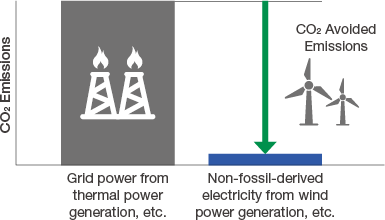
(2) Energy Savings
- We calculate the amount of CO2 emissions reduced by improving energy efficiency compared to products and services with equivalent functions
Examples: Compressors, elevators, etc.
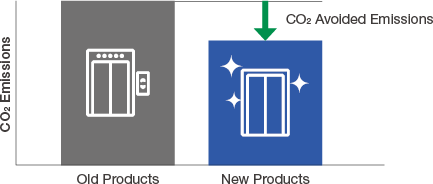
(3) Electrification
- We calculate the amount of CO2 emission reductions compared to products and services before electrification
Example: Electrification of industrial equipment
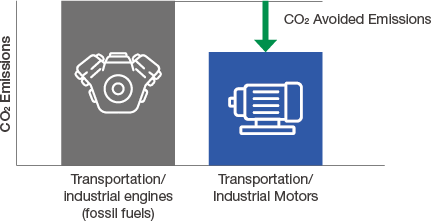
Improving the Environmental Performance of Products and Services through Eco-Design
Activities
Materiality
For all products and services involving a design process, Hitachi promotes eco-designs by applying our Environmentally Conscious Design Assessments to steadily improve environmental performance throughout the group. This assessment identifies a total of 30 environmental impact categories that affect climate change, resource depletion, and ecosystem degradation at each stage of the life cycle of products and services. In this way, we assess the reduction of environmental impact from business activities across multiple perspectives.
Initiatives for Improving Environmental Performance of Products and Services
- Promoting environmentally conscious processes: In accordance with the IEC 62430*1 criteria, promote environmentally conscious processes in designing and developing products and services, including by meeting environmental regulatory requirements and ascertaining the environment-related needs of our stakeholders within our existing management system.
- Implementing Life Cycle Assessments (LCAs): For our main, priority products, quantitatively evaluate their global environmental burden in such areas as the consumption of mineral resources, fossil fuels, and water resources, as well as their impact on climate change and air pollution, disclose the results to our stakeholders, and utilize them in improving the design of next-generation products.
*1IEC62430: The standard developed by the International Electrotechnical Commission (IEC) concerning environmentally conscious design for electrical and electronic products.
Approach to Transitioning to a Circular Economy/Innovation in Product DesignReduction of Product and Service CO2 Emissions During Use
Approach & Policy
Activities
CO2 emissions related to the use of products and services account for the largest proportion of emissions in our value chain. To reduce these emissions, Hitachi sets reduction rate targets per unit based on fiscal 2010 levels for each product or service targeted. We use functional size*1 as the denominator and CO2 emissions as the numerator in our target equation.
In fiscal 2023, we achieved our target with a reduction rate of 24% against a target of 13%. The achievement of this target was driven by the introduction of new models of high energy-saving equipment used in industrial equipment and social infrastructure.
We added the emissions of a consolidated energy-related company to the calculation of Hitachi Group emissions, resulting in a significant increase in emissions throughout the value chain. This increase is due to higher emissions from the use of transformers and other key products provided by the company that are used widely in the global power infrastructure. Hitachi will continue to bring energy-efficient products to the market.
*1Function size: Major functions of products correlated with CO2 emissions, such as their output and volume
Environmental Action Plan for 2024 Management Values
Reduction in CO2 Emissions per Unit (Hitachi Group)
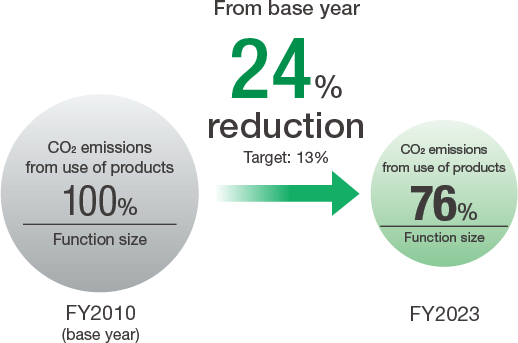
CO2 Emission Reductions at Business Sites (Factories and Offices) and Hitachi Carbon Neutrality 2030
Approach & Policy
Activities
Materiality
In working toward realizing a decarbonized society, Hitachi has set the goal of realizing carbon neutrality at all business sites (factories and offices) by fiscal 2030 as part of its long-term environmental targets.
To achieve our goals, we will promote initiatives by setting milestones of reducing CO2 emissions by 50% compared to the base year of fiscal 2024, and 80% by fiscal 2027.
CO2 emissions reduction measures at Hitachi include installing energy-saving and renewable energy equipment, and procurement of non-fossil power energy and utilization of energy attribute certificates*1. Among these, installing energy-saving and renewable energy equipment is expected to incur initial investment costs. However, it will also lead to reduced risks associated with factors including future energy price hikes and help address carbon pricing. It also aligns with our Corporate Mission—“To contribute to society through the development of superior, original technology and products”—and for this reason as well, we are placing a priority focus on this approach.
*1Energy attribute certificate: Accredits the environmental value associated with electricity generation from renewable energy sources. Unlike the purchase of renewable electricity, acquisition of this environmental value, which is separate from the electricity itself, is regarded as equivalent to using energy sources that do not emit CO2.
CO2 Reduction Roadmap
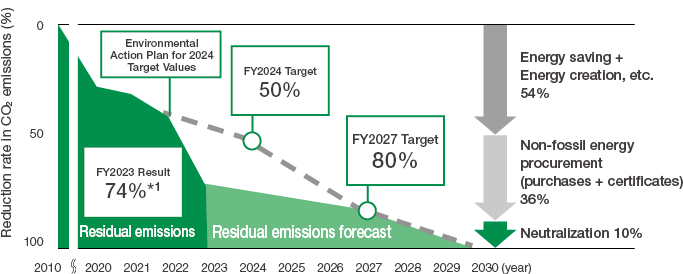
*1In fiscal 2023, the amount decreased due to the deconsolidation of auto parts-related companies.
Major Initiatives for Reducing CO2 Emissions at Business Sites (Factories and Offices)
Concrete efforts to achieve carbon neutrality at business sites, categorized by location type (factories, offices), can be outlined as shown below.
| Factories |
|---|
|
| Offices |
|
| Factories and Offices |
|
*1Corporate PPA: A contract whereby a corporation, municipality, or other legal entity purchases electricity generated by renewable energy from a power producer on a long-term basis (usually 10 to 25 years). PPA stands for power purchase agreement.
*2Additionality: An increase in effect of installing new renewable energy equipment.
The Hitachi Internal Carbon Pricing Framework
Activities
To promote CO2 reduction at its business sites (factories and offices), in fiscal 2019 Hitachi introduced the Hitachi Internal Carbon Pricing*1 (HICP) framework. Referencing emissions trading and carbon taxes globally, we establish internal carbon prices, and convert into monetary value as the effect of CO2 reductions due to investment in equipment that contributes to decarbonization. We add this price to the value of energy reduction effects, and use the result to evaluate the impact of our investment. By applying incentives like these, we aim to further expand our investment in equipment that contributes to decarbonization.
Increased burdens from carbon taxes and new emission regulations are anticipated in the future. Taking such risk factors into account from the stage of equipment investment considerations and placing a higher priority on investments that contribute to decarbonization will help minimize the impacts of future climate change risks and make our company more resilient. The introduction of the HICP framework is instrumental in this process.
Initially, we set the HICP rate at 5,000 yen/t-CO2 in consideration of 2025 carbon taxes and carbon trading prices (ETS*2). Subsequently, looking ahead to 2030, we increased the rate to 14,000 yen/t-CO2 in August 2021 in consideration of anticipated carbon taxes and carbon trading prices. We will leverage this framework to provide early responses to future risks such as carbon taxes as well as to actively promote the installation of energy-saving and renewable energy equipment, our highest priority initiative aimed at achieving carbon neutrality.
*1Internal carbon pricing: An in-house tool for assessing in monetary terms the amount of carbon generated or reduced in order to voluntarily make investment decisions and conduct risk management.
*2ETS: Emission Trading Scheme
Achievements in Fiscal 2023
Hitachi uses the HICP system to reduce CO2 emissions by converting CO2 reduction benefits of projects to monetary values to encourage additional investment, where such projects may not have received investment under the previous measurement standard.
In fiscal 2023 data, the number of adopted projects decreased to 52, reflecting the exclusion of auto parts-related companies that were previously included in Hitachi's consolidated subsidiaries until fiscal year 2022. However, due to an increase in the amount of investment, CO2 reductions increased to 4,302 tons.
We will continue to utilize the HICP system to reduce CO2 emissions.
Hitachi Internal Carbon Pricing (HICP) Framework
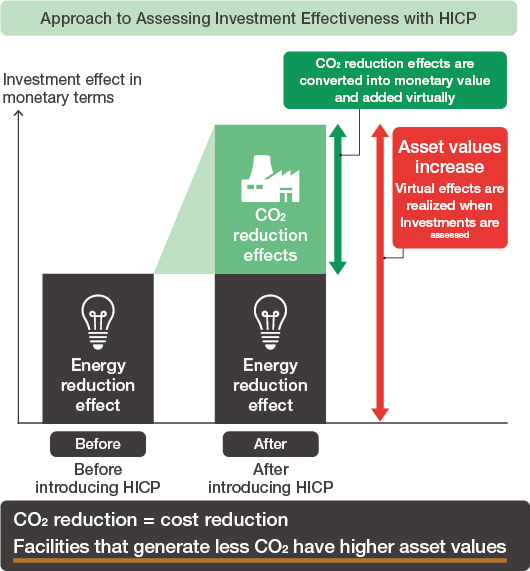
HICP Implementation Results
| Category | FY2019 | FY2020*1 | FY2021*1 | FY2022*1 | FY2023 |
|---|---|---|---|---|---|
| Number of HICP Projects | 35 | 22 | 59 | 94 | 52 |
| Investment (Million JPY) |
260 | 250 | 1,464 | 1,185 | 2,234 |
| CO2 Emissions Reduction (t-CO2) | 1,356 | 447 | 1,230 | 2,519 | 4,302 |
*1Excluding an energy-related company which became a consolidated subsidiary in fiscal 2020
Note :From August 2021, the set carbon price will be raised from ¥5,000/t-CO2 to ¥14,000/t-CO2.
Activities and Achievements at Business Sites (Factories and Offices)
Activities
The Hitachi Environmental Action Plan for 2024 states a target for the total CO2 reduction rate at business sites (factories and offices).
In fiscal 2023, the actual reduction in total CO2 emissions was 74%, surpassing the target of a 35% reduction (compared to the base year of fiscal 2010) by a significant margin. The significant improvement in fiscal 2023 results can be attributed to several factors. Firstly, auto parts-related companies that were previously included in Hitachi's consolidated subsidiaries until fiscal 2022 were no longer included, thus excluding their figures from the aggregate. Additionally, improvements in facility efficiency through the introduction and upgrading of high-efficiency equipment, as well as initiatives such as the installation of renewable energy systems and procurement of electricity from non-fossil energy sources, have contributed to this improvement.
Environmental Action Plan for 2024 Management Values
Reduction Rate of Total CO2 (Hitachi Group)
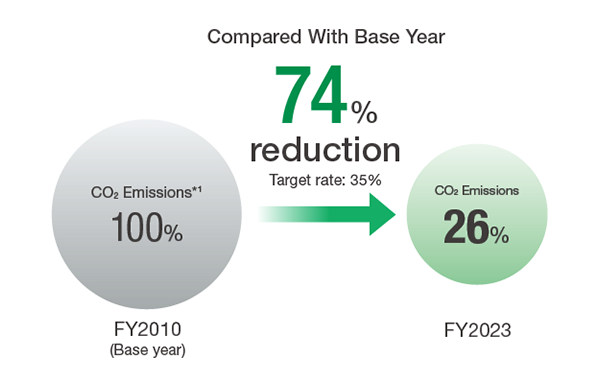
Note :Regarding CO2 electrical power conversion factors: We used adjusted conversion factors for individual power businesses based on the Act on Promotion of Global Warming Countermeasures in Japan. In China, we used the average emissions factor published by the government for regional power grids. For other countries, we used the latest values for each fiscal year supplied by the International Energy Agency (IEA) for individual countries or by power supply companies.
Note :The Environmental Action Plan’s management values do not include amounts for our power plants in fiscal 2010 (base year) or fiscal 2023
Note :Only for Environmental Action Plan for 2024 management values, emissions of 15.7 kt-CO2 from the cancellation of credits for neutralization were deducted. For the figures that underwent independent assurance, emissions from the cancellation of credits for neutralization were not deducted.
*1CO2 emitted from the organization (Scope 1 and 2).
CO2 Emissions (Hitachi Group’s Factories, Offices, and Power Plants)
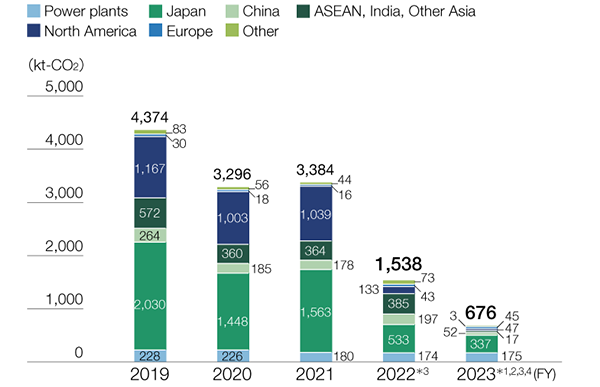
*1Energy-derived CO2 emissions in fiscal 2023 amounted 339 kt-CO2 (Scope 1) and 279 kt-CO2 (Scope 2, market basis)
*2In fiscal 2023, the amount decreased due to the deconsolidation of auto parts-related companies.
*3CO2 emissions disclosed only in category A until fiscal 2022, and in categories A, B, and C (excluding non-manufacturing sites for category C) in fiscal 2023.
*4In fiscal 2023, the amount includes non-energy-related GHG emissions (kt-CO2e).
Introducing Renewable Energy
Activities
To reduce CO2 emissions, Hitachi installs renewable energy power generation equipment on our premises. We also procure electricity produced through new renewable energy equipment located off-premises. We are expanding the use of corporate PPA to accelerate the replacement of fossil fuel-derived electricity with electricity derived from renewable energy sources.
Renewable electricity used will be based on the standards set by the GHG Protocol.
Achievements in Fiscal 2023
Renewable electricity generation across the Hitachi Group in fiscal 2023 amounted to 769 GWh.
This amounted to 56% of the electricity usage within the target range, a significant increase from 24% in the previous year.
At 58 sites in the United States, Europe, China, Japan and some other countries in Asia, all electricity used came from renewable sources. Eighteen of these sites achieved carbon neutrality through enhanced energy-savings and purchases of credits for neutralization.
In addition, Hitachi Energy is working actively to decarbonize operations through the use of non-fossil fuel electricity for all of its in-house electricity usage. Meanwhile, Hitachi Industrial Equipment Systems has achieved carbon neutrality at its major factories by directly and indirectly reducing Scope 1 and Scope 2 CO2 emissions originating from energy.
Locations Operating on Non-fossil Energy
| Country/Region | Sites Using 100% Renewable-Derived Electricity | |
|---|---|---|
| Carbon Neutrality | ||
| Europe | 18 sites | 2 sites (Hitachi Energy Group) |
| North America | 9 sites | 1 site (Hitachi Industrial Equipment Systems Group) |
| China | 6 sites | 2 sites (Hitachi Industrial Equipment Systems Group) |
| Japan | 10 sites | 4 sites (Hitachi High-Tech Group) 6 sites (Hitachi Industrial Equipment Systems Group) |
| Asia (Excluding China and Japan) | 8 sites | 2 sites (Hitachi Energy Group) 1 site (Hitachi Industrial Equipment Systems Group) |
| Other | 7 sites | — |
| Total | 58 sites | 18 sites |
Initiatives to Reduce CO2 Emissions from Purchased Goods and Services
Activities
Hitachi is also working to reduce emissions from purchased goods and services (Scope 3, Category 1) in order to achieve carbon neutrality across the entire value chain by fiscal 2050. In fiscal 2023, we selected approximately 100 companies from procurement partners with the highest Scope 3 Category 1 emissions, and key procurement partners in Hitachi's business activities to engage in reduction activities. Hitachi has been working to understand the amount of CO2 reductions upstream in Hitachi's value chain by obtaining reduction plans from relevant partners and analyzing the details of these plans.
Efforts Toward Carbon Neutrality in the Value Chain UpstreamReducing Transportation Energy Consumption
Activities
In addition to reducing energy used at our business sites (factories and offices), Hitachi strives to reduce energy usage during transportation. Each business unit (BU) and Group company incorporates the rate of reduction in transportation energy use per unit in Japan, with voluntary targets established in other countries.
Our business sites pursue modal shifts to highly efficient transportation methods by improving truck loading ratios, taking other measures to reduce transportation energy consumption and switching to the use of eco-cars for in-house operations.
Achievements in Fiscal 2023
Fiscal 2023 reduction measures focused on improving loading efficiency for product transportation, utilizing joint transportation, and optimizing transportation vehicles. With the deconsolidation of auto parts-related companies, CO2 emissions from transportation in Japan totaled 17.8 kt-CO2, a decrease of 9.1 kt-CO2 compared with fiscal 2022.
Hitachi Fleet Management Reduces CO2 Emissions from Business Vehicles
Approach & Policy
Hitachi is preparing to electrify our fleet of commercial vehicles as part of efforts to achieve carbon neutrality by fiscal 2050. However, we must address a variety of issues that companies face when introducing electric vehicles, including the limited choice of electric vehicles and the lack of charging infrastructure.
To this end, we created our own fleet management plan to prepare for fleet electrification at each BU and Group company. Specifically, we intend to use BPO*1 and AI drive recorders*2 to visualize vehicle operating conditions, followed by an analysis of collected driving data and CO2 emissions monitoring. We will use the results of this analysis and monitoring to reduce CO2 emissions from existing vehicles and advance the gradual replacement of existing vehicles with electric vehicles to reduce CO2 emissions from business-use vehicles.
*1BPO: Abbreviation of business process outsourcing. BPO outsources the entirety of a business process to a contractor specializing in said activity.
*2AI drive recorder: A service that uses AI to analyze recorded driving video and visualize signs of dangerous driving and driver tendencies.
Hitachi Fleet Management
| Vehicle Visualization | Centralized fleet management via BPO |
|---|---|
| AI drive recorders to monitor vehicle operation status |

| Vehicle Data Analysis | Analysis of vehicle operation status and travel routes |
|---|---|
| Analysis of driver tendencies | |
| Continuous monitoring of electrification rates and CO2 emissions |

| Actions to Reduce CO2 Emissions | Optimizing the number of vehicles in the fleet based on vehicle utilization status |
|---|---|
| Encouraging eco-driving by controlling sudden acceleration and braking | |
| Fostering awareness of CO2 reductions via visualizations of emissions | |
| Phased-in vehicle electrification in consideration of impact on operations |
Achievements in Fiscal 2023
In fiscal 2023, as part of our reduction initiatives, we focused on utilizing Business Process Outsourcing (BPO) for centralized vehicle management and installed AI dashcams to monitor vehicle use. We have implemented these measures into 60% of our commercial vehicles in Japan and working towards expanding this initiative, aiming to reach 80% in the future.
Note :Hitachi normally refers to suppliers (including vendors or providers) as procurement partners who build business together on an equal footing.